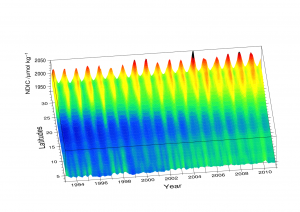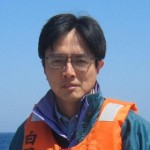Masao Ishii
Ocean Biogeochemical Dynamics in the Kuroshio Recirculation Gyre
The Kuroshio Recirculation Gyre that extends to the south and southeast of Japan is a major reservoir of the excess CO2 being released to the atmosphere by fossil fuel combustions and land-use changes. However, the enigmas of the biogeochemical dynamics in this region are yet to be resolved.
In the surface layer of this region, macro-nutrients such as nitrate are depleted for the most time of a year. Accordingly, the new production, i.e., the primary production being supported by nutrients inputs from outside of the euphotic zone, has been considered as being controlled by the upward supply of nutrients from nutricline below the winter mixed layer and occurred in the lower euphotic layer. However, in 1990s when a method of high-precision measurements of total dissolved inorganic carbon (DIC) became available, it was found that the DIC decreases by ~40 µmol kg-1 and dissolved organic carbon increases concurrently in summer. In addition, it was recently clarified with high-resolution data from oxygen sensor on profiling floats and on CTD that shallow oxygen maximum (SOM) develops in summer in the lower euphotic layer well above the nutricline and chlorophyll maximum. These results of in-situ measurements suggest that the new production in the Kuroshio recirculation in the subtropics is not simply controlled by the one-dimensional upward supply of nutrients but other unknown processes are involved in the biogeochemical dynamics.
In this study, we will evaluated the variability of CO2 system parameters, dissolved oxygen, and macro-nutrients in space and time in the surface, around SOM, and subtropical mode water (STMW) below in the Kuroshio Recirculation Gyre. The region of the analysis extends from the Kuroshio Extension where STMW is formed in winter and excess CO2 and dissolved oxygen are transported from the surface into the interior, to the down-stream region near the Nansei Islands where STMW has been partly eroded due to diffusion and DIC and macro-nutrients have been increased and dissolved oxygen has decreased as a result of remineralization during the course of advection. We will mainly analyze the physical and biogeochemcal data collected by Japan Meteorological Agency. New high-quality data we will take during R/V Hakuho-maru’s cruises and high-resolution data to be taken with an autonomous underwater glider will also be used for these analyses. These biogeochemical fields are expected to help understanding the biogeochemical dynamics in the Kuroshio Recirculation Gyre.

Fig.1 Time-latitude distribution of salinity normalized total dissolved inorganic carbon (NDIC) at S=35 at 137°E, 3°N-34°N for 1993 – 2010. Significant seasonal variability and trend toward increase are seen in the Kuroshio Recirculation zone to the north of around 20°N.
Principal Investigator:
Masao Ishii
Section Chief, Meteorological Research Institute (MRI), Japan Meteorological Agency, Chemical Oceanography
Collaborators:
Daisuke Sasano (Researcher, Meteorological Research Institute (MRI), Japan Meteorological Agency, Chemical Oceanography)
Naohiro Kosugi (Researcher, Meteorological Research Institute (MRI), Japan Meteorological Agency, Chemical Oceanography)
Katsuya Toyama (Researcher, Meteorological Research Institute (MRI), Japan Meteorological Agency, Physical Oceanography)
Yuko Omori (Assistant Professor, Faculty of Life and Environmental Sciences, University of Tsukuba, Marine Ecology and biogeochemistry)
Joint Cooperators:
Toshiya Nakano (Section Chief, Global Environment and Marine Department, Japan Meteorological Agency, Physical Oceanography)
Shinji Masuda (Senior Technical Officer, Global Environment and Marine Department, Japan Meteorological Agency, Chemical Oceanography)
Yosuke Iida (Technical Officer, Global Environment and Marine Department, Japan Meteorological Agency, Chemical Oceanography)
Atsushi Kojima (Technical Officer, Global Environment and Marine Department, Japan Meteorological Agency, Physical Oceanography)
Hisashi Ono (Technical Officer, Global Environment and Marine Department, Japan Meteorological Agency, Geophysics)


